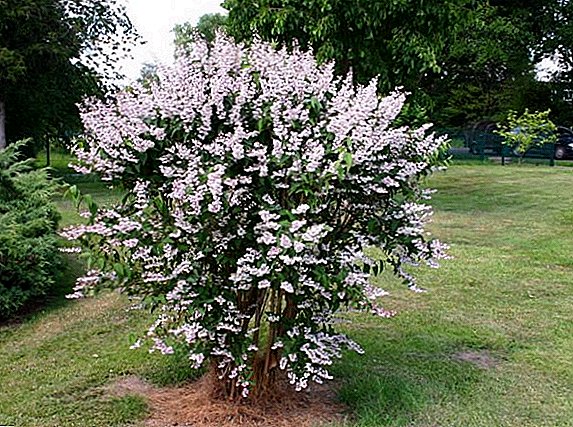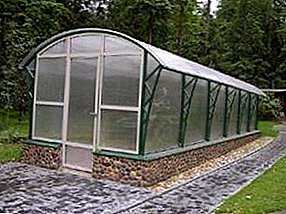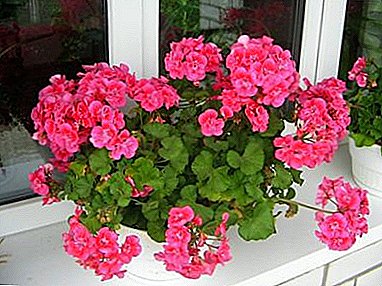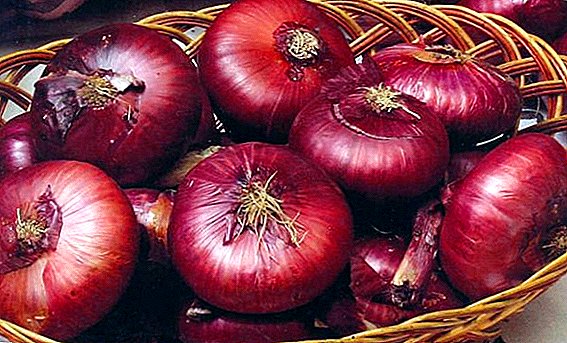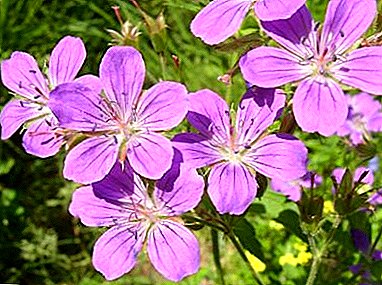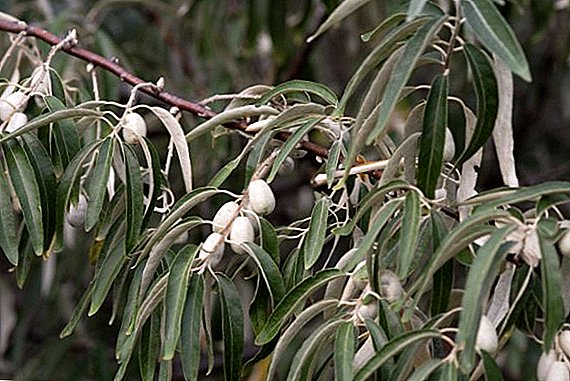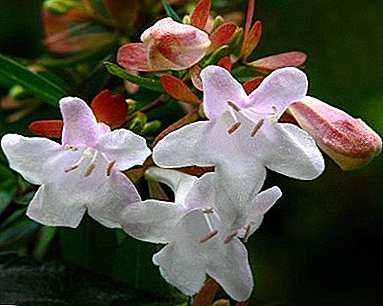
The genus of abelias growing in Mexico and East Asia has 30 species.
In general, it is evergreen or deciduous, long-flowering shrubs, trees, as a rule, reaching a height of 2.5 - 4 m.
They perfectly tolerate pruning and form attractive hedges. Abelias are grown mainly in a fairly warm belt, mainly in open ground.
There is, however, a hybrid variety with fragrant flowers-bells, dense foliage and pink shoots - abelia large-flowered (Abelia grandiflora), which develops well in room culture.
Photo
Abelia grandiflora: photo of this species of plant.



Home care
Lighting
Light is required bright but diffused, with protection from excessively intense solar radiation.
The southeast and southwest windows can be considered as the best, but even there on nice days, when the summer sun becomes too much, the plant is better covered with a light mesh fabric.
Summer "holidays" on a balcony or a site are useful to home large-flowered abelias.
Temperature
Summer temperature optimum - 20-25 degrees.
In winterIn order to preserve foliage, abelia grandiflora is kept at a temperature not lower than 10-15 degrees.
Abelia is reconciled with a high wintering temperature. In this case, you will need the appropriate moisture regime - more frequent than with a cool winter content, watering and additional spraying.
The soil
Good results gives landing in nutrient and loose soil with a weak acid reactionFor example, in a mixture containing fertile components - humus, leaf and sod land with the addition of baking powder - sand, as well as an acidifier - peat.
These ingredients are taken in equal amounts.
Suitable and universal soil for indoor floriculture.
Landing
 The seating capacity can be quite spacious: Abelian roots develop at high speed. Drooping shoots, elegant foliage and clusters of inflorescences look advantageous in hanging containers.
The seating capacity can be quite spacious: Abelian roots develop at high speed. Drooping shoots, elegant foliage and clusters of inflorescences look advantageous in hanging containers.
Required significant drainage layer - When caring for Abelia, prolonged waterlogging of the soil is unacceptable.
For better water permeability, coarse sand can be poured over the drainage layer, then a little bit of soil, and plant roots should be placed on it, preferably together with the earth clod woven by them.
Then fill the nutrient soil to the required level and pour.
Transfer
Young room abelians are transplanted every year, in the spring time (with intensive growth - more often), mature specimens - after a year or less, by transshipment.
Watering
Large-flowered abelia requires regular watering in the spring-summer period, and during the wintering period - somewhat more rare, in order to prevent the earthen coma from drying out.
Irrigation water should be soft, not cold. The most important thing is to establish such a mode of water intake, in which the soil will remain well-moistened, but not too wet.
The plant does not tolerate stagnant moisture.
Air humidity
In summer time should be carried out systematically spraying with cool water.
In winter, in warm apartments with central heating, spraying is carried out less often, but they do not stop at all.
If wintering takes place at a reduced temperature, abelia is not sprayed.
Top dressing
From early spring to early autumnTwice a month, they provide supplemental feeding with a mineral complex intended for flowering houseplants.
Good results are also given by the alternation of mineral dressing with organic fertilizer.
Growth and pruning
 Abelia grows rapidly, pulling in length twice in the spring-summer period.
Abelia grows rapidly, pulling in length twice in the spring-summer period.
To shape the bush was more compact and lush, shoots are cut in half after the flowering periodin the fall.
Spring pruning is also practiced, especially after warm keeping in winter. The shoots are shortened by a third, removing stretches over the winter.
It stimulates active branching with abundant formation of new foliage and buds.
Bloom
Flowering season continues from June to October. Inflorescences of "bluebells", painted, depending on the variety, in pinkish-white, richly pink or purple tones, have a strong pleasant aroma.
Strong pruning increases the intensity of flowering.
Breeding
You can propagate this plant with seeds and cuttings.
Seeds
Sowing is carried out in Januaryin a light soil consisting of coarse sand and leafy earth in the same proportion.
Cover with plastic film and contain, regularly aerating and moisturizing, at a temperature of 20-22 degrees. Sprouts appear quickly.
As they grow, the seedlings are transplanted into dense soil. In the same year they bloom.
Stem cuttings
In the spring cut the cuttings of 5-6 cm in length and send them for rooting at 18–20 degrees to a moist mixture of coarse-grained sand with peat.
Cover with a polyethylene film, sprayed, aerated, moistened the substrate.
When rooting has occurred and new shoots have appeared (usually it takes 2-3 weeks), young plants are planted in more nutritious soil.
Abelia, obtained from cuttings, bloom the same summer or next year.
Possible problems
 The plant does not bloom, his leaves turn pale - lack of lighting. It is necessary to rearrange the container in a brighter place.
The plant does not bloom, his leaves turn pale - lack of lighting. It is necessary to rearrange the container in a brighter place.
Leaves turn yellow and dry, starting at the tips. - insufficient soil and / or air moisture.
It is necessary to optimize the mode of watering and spraying.
In the summer, dry brown areas are formed on the leaves. - sunburn. Abelius needs to pritenit.
Diseases and pests
Intensively growing, viable abelia suffers more from improper care than from diseases.
On specimens weakened by improper care, especially in dry air, they settle spider mite, scale insects, thrips, mealybugs.
As an ambulance use soapy water or decoctions of wormwood, dandelion, potato or tomato tops. The most effective means of pest control are insecticides of systemic action.
Abelia Grandiflora - room representative of blooming "hedges" - undemanding, viable plant, covered with fragrant inflorescences throughout the summer.
With good lighting and adequate care, large-flowered abelia is a true decoration and natural summer fragrance of the room.



